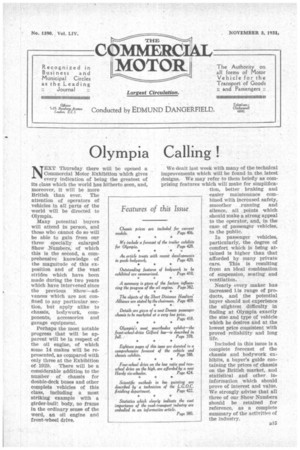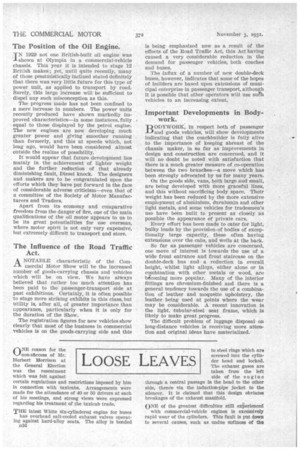Olympia Calling !
Page 101

Page 102

If you've noticed an error in this article please click here to report it so we can fix it.
NEXT Thursday there will be opened a Commercial Motor Exhibition which gives every indication of being the greatest of Its class which the world has hitherto seen, and, moreover, it will be more British than ever. The attention of operators of vehicles in all parts of the world will be directed to Olympia.
Many potential buyers will attend in person, and those who cannot do so will be able to gain from our three specially enlarged Show Numbers, of which this is the second, a comprehensive knowledge of the magnitude of this exposition and of the vast strides which have been made during the two years which have intervened since the previous Show-advances which are not confined to any particular section, but apply alike to chassis, bodywork, components, accessories and garage equipment.
Perhaps the most notable progress that will be apparent will be in respect of the oil engine, of which some 14 makes will be represented, as compared with only three at the Exhibition of 1929. There will be a considerable addition to the number of chassis for double-deck buses and other complete vehicles of this class, including a most striking example with a girder-built body, no frame In the ordinary sense of the word, an oil engine and front-wheel drive. We dealt last week with many of the technical improvements which will be found in the latest designs. We may refer to them briefly as cornprising features which will make for simplifica tion, better braking and easier maintenance cornbined with increased safety, smoother running and silence, all points which should make a strong appeal to the operator, and, in the case of passenger vehicles, to the public.
In passenger vehicles, particularly, the degree of comfort which IS being attained is higher than that afforded by many private cars. This is resulting from an ideal combination of suspension, seating and ventilation, Nearly every maker has increased Lis range of products, and the potential buyer should not experience the slightest, difficulty in finding at Olympia exactly the size and type of vehicle which he desires and at the lowest price consistent with proved reliability and Tong Life.
Included in this issue is a complete forecast of the chassis and bodywork exhibits, a buyer's guide containing the prices of chassis on the British market, and statistical and other ininformation which should prove of interest and value. We strongly advise that all three of our Show Numbers should be retained for reference, as a complete summary of the activities of the industry.
The Position of the Oil Engine.
TN 1929 not one British-built oil engine was -shown at Olympia in a commercial-vehicle chassis. This year it is intended to stage 12 British makes; yet, until quite recently, many of those pessimistically inclined stated definitely that there was very little future for this type of power unit, as applied to transport by road. Surely, this large increase will be sufficient to dispel any such misconception as this.
The progress made has not been confined to a mere increase in numbers. The power units recently produced have shown markedly improved characteristics—in some instances, fully 4 equal to those displayed by the petrol engine. The new engines are now developing much greater power and giving smoother running than formerly, and this at speeds which, not long ago, would have been considered almost outside the realms of possibility.
It would appear that future development lies mainly in the achievement of lighter weight and the further reduction of that already diminishing fault, Diesel knock. The designers and makers are to be congratulated upon the efforts which they have put forward in the face of considerable adverse criticism—even that of a committee of the Society of Motor Manufacturers and Traders.
Apart from its economy and comparative freedom from the danger of fire, one of the main qualifications of the oil motor appears to us to be its great potentialities for use overseas, where motor spirit is not only very expensive, hut extremely difficult to transport and store.
The Influence of the Road Traffic Act.
NOTABLE characteristic of the Commercial Motor Show will he the increased number of goods-carrying chassis and vehicles which will be on view. We have always believed that rather too much attention has been paid to the passenger-transport side at past exhibitions. Certainly, it is often possible to stage more striking exhibits in this class, but utility is, after all, of greater importance than appearance, particularly when it is only for the duration of the Show.
The registration figures for new vehicles show clearly that most of the business in commercial vehicles is on the goods-carrying side and this is being emphasized now as a result of the effects of the Road Traffic Act, this Act having caused a very considerable reduction in' the demand for passenger vehicles, both coaches and buses.
The influx of a number of new double-deck buses, however, indicates that some of the hopes of builders are based upon extensions of municipal enterprise in passenger transport, although It is possible that other operators will use sunk vehicles to an increasing extent.
Important Developments in Bodywork.
11Q IC ODYWOR, in respect both of passenger -I-laud goods, vehicles, will show developments indicating that the coachbuilder is fully alive to the importance of keeping abreast of the chassis maker, in so far as improvements in design and construction are concerned, and it will no doubt be noted with satisfaction that there is a much greater measure of co-operation between the two branches—a move which has been strongly advocated by its for many years.
On the goods side, vans, both large and small, are being developed with More graceful lines, and this without sacrificing body space. Their weight has been reduced by the more extensive employment of aluminium, duralumin and other light metals, and some vehicles for tradesmen's use have been built to present as closely as possible the appearance of private cars.
Every effort has been made to cater for light, bulky loads by the provision, of bodies of exceptionally large capacity, these often having extensions over the cabs, and wells at the back.
So far as passenger vehicles are concerned, one move of interest is towards the use of a wide front entrance and front staircase on the double-deck bus and a reduction in overall height, whilst light alloys, either alone or in combination with other metals or wood, are hicoming more popular. Many of the interior fittings are chromium-finished and there is a general tendency towards the use of a combination of leather and moquette upholstery, the leather being used at points where the wear may be considerable. A recent innovation is the light, tubular-steel seat frame, which is likely to make great progress.
The difficult problem of luggage disposal on long-distance vehicles is receiving more attention and original ideas have materialized.








































































































































































































































